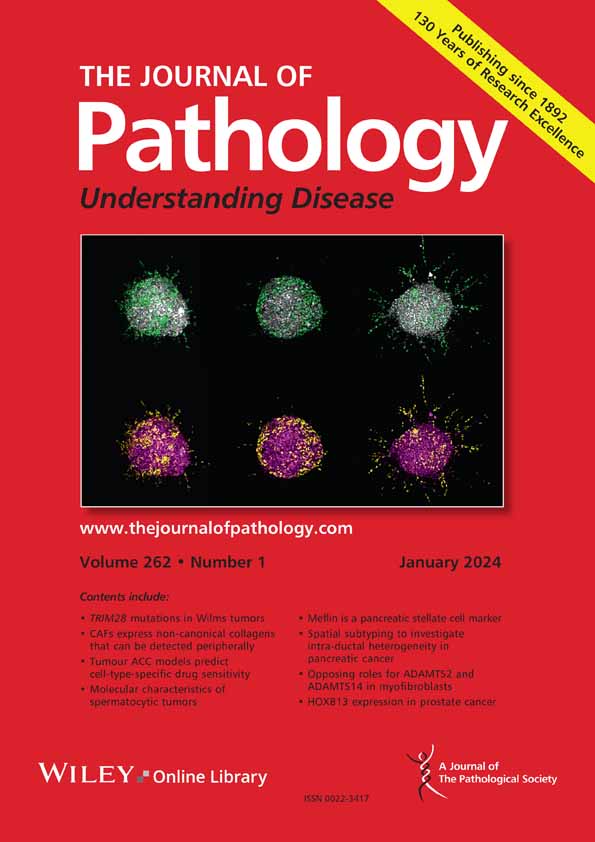Joachim T Siaw, Peter Merseburger, Marcus Borenäs, Caroline Jansson, Jenny Karlsson, Arne Claeys, Eva Jennische, Dan E Lind, David Gisselsson Nord, Ruth H Palmer, Jimmy Van den Eynden
下载PDF
{"title":"Spatial transcriptomics exploration of the primary neuroblastoma microenvironment in archived FFPE samples unveils novel paracrine interactions","authors":"Joachim T Siaw, Peter Merseburger, Marcus Borenäs, Caroline Jansson, Jenny Karlsson, Arne Claeys, Eva Jennische, Dan E Lind, David Gisselsson Nord, Ruth H Palmer, Jimmy Van den Eynden","doi":"10.1002/path.6457","DOIUrl":null,"url":null,"abstract":"<p>High-risk neuroblastomas exhibit a high degree of intratumoral heterogeneity. Single-cell RNA sequencing has greatly improved our understanding of these tumors, but the method lacks cellular tissue context and spatial information about local signaling dynamics. To address this, we profiled untreated and chemotherapy-treated high-risk neuroblastomas from archived, formalin-fixed, paraffin-embedded (FFPE) tissues from two patients using spatial transcriptomics. We confirmed the transcriptional and cellular heterogeneous nature of the neuroblastoma microenvironment and identified several unique spatial niches and patterns. In one of the treated tumors, a spatially constrained cluster of undifferentiated and 11p-gained cancer cells was identified, surrounded by a rim of macrophages. A signaling interaction between the chemokine <i>CCL18</i> and its receptor <i>PITPNM3</i> was predicted between these cells. In the other tumor, we identified a stromal cluster with high transcriptional similarity to the adrenal cortex. These adrenocortical-like cells expressed several oncogenic ligand-encoding genes (e.g. <i>ALKAL2</i> and <i>NRTN</i>), which were predicted to communicate with neighboring cancer cells that expressed the corresponding receptors (e.g. <i>ALK</i>, <i>RET</i>). Several of these interactions were further validated experimentally and were shown to be clinically relevant. Collectively, our spatial analysis identifies multiple previously unrecognized signaling axes that may offer novel therapeutic options in neuroblastoma. © 2025 The Author(s). <i>The Journal of Pathology</i> published by John Wiley & Sons Ltd on behalf of The Pathological Society of Great Britain and Ireland.</p>","PeriodicalId":232,"journal":{"name":"The Journal of Pathology","volume":"267 2","pages":"181-195"},"PeriodicalIF":5.2000,"publicationDate":"2025-08-08","publicationTypes":"Journal Article","fieldsOfStudy":null,"isOpenAccess":false,"openAccessPdf":"https://www.ncbi.nlm.nih.gov/pmc/articles/PMC12438011/pdf/","citationCount":"0","resultStr":null,"platform":"Semanticscholar","paperid":null,"PeriodicalName":"The Journal of Pathology","FirstCategoryId":"3","ListUrlMain":"https://pathsocjournals.onlinelibrary.wiley.com/doi/10.1002/path.6457","RegionNum":2,"RegionCategory":"医学","ArticlePicture":[],"TitleCN":null,"AbstractTextCN":null,"PMCID":null,"EPubDate":"","PubModel":"","JCR":"Q1","JCRName":"ONCOLOGY","Score":null,"Total":0}
引用次数: 0
引用
批量引用
Abstract
High-risk neuroblastomas exhibit a high degree of intratumoral heterogeneity. Single-cell RNA sequencing has greatly improved our understanding of these tumors, but the method lacks cellular tissue context and spatial information about local signaling dynamics. To address this, we profiled untreated and chemotherapy-treated high-risk neuroblastomas from archived, formalin-fixed, paraffin-embedded (FFPE) tissues from two patients using spatial transcriptomics. We confirmed the transcriptional and cellular heterogeneous nature of the neuroblastoma microenvironment and identified several unique spatial niches and patterns. In one of the treated tumors, a spatially constrained cluster of undifferentiated and 11p-gained cancer cells was identified, surrounded by a rim of macrophages. A signaling interaction between the chemokine CCL18 and its receptor PITPNM3 was predicted between these cells. In the other tumor, we identified a stromal cluster with high transcriptional similarity to the adrenal cortex. These adrenocortical-like cells expressed several oncogenic ligand-encoding genes (e.g. ALKAL2 and NRTN ), which were predicted to communicate with neighboring cancer cells that expressed the corresponding receptors (e.g. ALK , RET ). Several of these interactions were further validated experimentally and were shown to be clinically relevant. Collectively, our spatial analysis identifies multiple previously unrecognized signaling axes that may offer novel therapeutic options in neuroblastoma. © 2025 The Author(s). The Journal of Pathology published by John Wiley & Sons Ltd on behalf of The Pathological Society of Great Britain and Ireland.
对存档的FFPE样本中原发性神经母细胞瘤微环境的空间转录组学探索揭示了新的旁分泌相互作用。
高危神经母细胞瘤表现出高度的肿瘤内异质性。单细胞RNA测序极大地提高了我们对这些肿瘤的理解,但该方法缺乏细胞组织背景和局部信号动力学的空间信息。为了解决这个问题,我们使用空间转录组学分析了来自两名患者的未治疗和化疗的高风险神经母细胞瘤,这些神经母细胞瘤来自存档的、福尔马林固定的石蜡包埋(FFPE)组织。我们证实了神经母细胞瘤微环境的转录和细胞异质性,并确定了几个独特的空间壁龛和模式。在其中一个接受治疗的肿瘤中,发现了一个空间受限的未分化和11p获得的癌细胞簇,周围环绕着巨噬细胞。预测趋化因子CCL18与其受体PITPNM3之间的信号相互作用在这些细胞之间。在另一个肿瘤中,我们发现了一个与肾上腺皮质具有高度转录相似性的基质簇。这些肾上腺皮质样细胞表达几种致癌配体编码基因(如alk2和NRTN),预计这些基因会与表达相应受体(如ALK, RET)的邻近癌细胞进行交流。其中一些相互作用得到了进一步的实验验证,并被证明与临床相关。总的来说,我们的空间分析确定了多个以前未被识别的信号轴,这些信号轴可能为神经母细胞瘤提供新的治疗选择。©2025作者。《病理学杂志》由John Wiley & Sons Ltd代表大不列颠和爱尔兰病理学会出版。
本文章由计算机程序翻译,如有差异,请以英文原文为准。





 求助内容:
求助内容: 应助结果提醒方式:
应助结果提醒方式:


